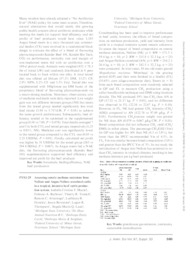Assessing enteric methane emissions from Nellore and Angus-Nellore crossbred cattle in a tropical, intensive beef cattle production system.
Assessing enteric methane emissions from Nellore and Angus-Nellore crossbred cattle in a tropical, intensive beef cattle production system.
Autoria: MACIEL, I. C. F.; BARBOSA, F. A.; TOMICH, T. R.; ALVARENGA, R. C.; FERREIRA, L. R.; ROWNTREE, J.; THOMPSON, L. R.; LANA, A. M. Q.
Resumo: Crossbreeding has been used to improve performance in beef cattle; however, the effects of breed composition on methane production, yield and intensity from cattle in a tropical intensive system remain unknown. To assess the impact of breed composition on enteric methane emissions, Nellore (NE; yr 1: BW = 171.5 ± 19.4 kg; n = 10; yr 2: BW = 215.8 ± 32.3 kg, n = 25) and Angus-Nellore crossbred (AN; yr 1: BW = 214.2 ± 26.4 kg, n = 10; yr 2: BW = 242.5 ± 32.2 kg, n = 25) were compared. At trial onset, 10 mo old steers grazed Megathyrsus maximus ?Mombaça? in the grazing period (GP) and then were finished in a feedlot (FL) (35:65% corn silage:concentrate diet). Steers (n = 8) from each breed composition were randomly selected in GP and FL to measure CH4 production using a sulfur hexafluoride technique and DMI using titanium dioxide. The NE produced 19% less CH4 than AN in GP (17.21 vs 21.17 kg, P < 0.01), and no difference was observed in FL (22.34 vs 22.67 kg, P > 0.10). However, in FL, NE had greater CH4 intensity (CH4/ADG) compared to AN (122.76 vs 97.49 g/kg, P < 0.01). Furthermore, CH4/carcass weight was greater for NE than AN (0.079 vs 0.067 g/kg CW, P < 0.01). Breed composition did not influence CH4 yield (CH4/DMI) in either phase. The percentage CH4/GEI (Ym) for GP was higher for AN than NE (4.5 vs 3.8%), but lower than the IPCC recommended Ym of 6.5%. In FL, Ym was similar between breed composition (5.0%) and greater than the IPCC Ym of 3%. In our study the introduction of Angus into Nellore has potential to reduce CH4 intensity in tropical climates, resulting in less methane emission per kg beef produced.
Ano de publicação: 2019
Tipo de publicação: Resumo em anais e proceedings
Unidade: Embrapa Milho e Sorgo
Palavras-chave: Bovino, Efeito Estufa, Gado de Corte, Gás, Intensificação sustentável, Metano, Ruminante, Sistema intensivo de produção
Observações
1 - Por padrão são exibidas publicações dos últimos 20 anos. Para encontrar publicações mais antigas, configure o filtro ano de publicação, colocando o ano a partir do qual você deseja encontrar publicações. O filtro está na coluna da esquerda na busca acima.
2 - Para ler algumas publicações da Embrapa (apenas as que estão em formato ePub), é necessário ter, no celular ou computador, um desses softwares gratuitos. Sistemas Android: Google Play Livros; IOS: iBooks; Windows e Linux: software Calibre.
Acesse outras publicações
Acesse a Base de Dados da Pesquisa Agropecuária (BDPA) para consultar o acervo completo das bibliotecas da Embrapa.

